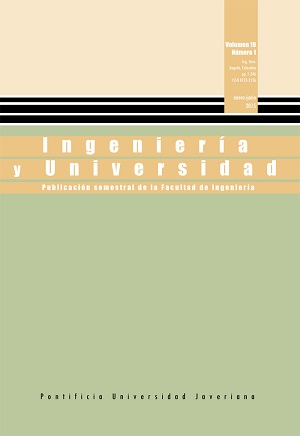Resumen
Este artículo describe una nueva técnica para controlar la fracción de aire fresco en el colector de admisión de motores Diesel con doble circuito de recirculación de gases de escape (RGE). Esta estrategia de control permite regular eficientemente la fracción de aire, satisfaciendo al mismo tiempo una proporción deseada entre las RGEs de alta y baja presión. Basado en un modelo físico de la dinámica de la fracción de aire a lo largo del sistema de aire del motor, un regulador lineal cuadrático a parámetros variables (LPV-LQR) es diseñado para asegurar la estabilidad de la fracción de aire y minimizar un índice de desempeño cuadrático. La controlabilidad del sistema, necesaria para garantizar la existencia del controlador LPV-LQR, se verifica mediante la definición de un subespacio convexo de parámetros utilizando un enfoque politópico. El controlador es evaluado bajo fuertes condiciones transitorias utilizando como referencia, un modelo del motor validado experimentalmente.
[2] M. Alriksson and I. Denbrantt, “Low temperature combustion in a heavy duty Diesel engine using high levels of EGR”, SAE Technical Paper 2006-01-0075, 2006.
[3] T. Ryan and A. Matheaus, “Fuel requirements for HCCI engine operation”, SAE transactions-J Fuels Lubr, vol. 112, no. 1, pp. 1143-1152, 2003.
[4] A. Hribernik, “Effect of the exhaust gas recirculation on Diesel combustion”, J KONES Internal Combustion Engines, vol. 11, no. 1, pp. 223-231, 2004.
[5] M. Ammann et al., “Model-based control of the VGT and EGR in a turbocharged common-rail Diesel engine: theory and passenger car implementation”, SAE Technical Paper 2003-01-0357, 2003.
[6] J. Chauvin, G. Corde, and N. Petit, “Constrained motion planning for the airpath of a Diesel HCCI engine”, en Proceedings of the 45th IEEE Conference on Decision and Control, 2006. pp. 3589-3596.
[7] J. Chauvin et al., “Motion planning for experimental airpath control of a Diesel homogeneous charge-compression ignition engine”, Control Engineering Practice, vol. 16, 1081- 1091, 2008.
[8] J. Wang, “Hybrid robust control for engines running low temperature combustion and conventional Diesel combustion modes”, IEEE Transactions Control Syst Technol, vol. 16, no. 6, pp. 1138-1151, 2007.
[9] M. Herceg et al., “Nonlinear model predictive control of a turbocharged Diesel engine”, en Proceedings of the IEEE International Conference on Control Applications, 2006. pp. 2766-2771.
[10] O. Grondin, P. Moulin, and J. Chauvin, “Control of a turbocharged Diesel engine fitted with high pressure and low pressure exhaust gas recirculation systems”, en Proceedings of the 48th IEEE Conference on Decision and Control, Shanghai, 2009. pp. 6582-6589.
[11] F. Yan and J. Wang, “Control of a dual loop EGR air-path systems for advanced combustion Diesel engines by singular perturbation methodology”, en Proceedings of the American Control Conference, 2011. pp. 1561-1566.
[12] G. Bression et al., “Comparative study in LTC combustion between a short HPEGR loop without cooler and a variable lift a duration system”, en Proceedings of the 17th Aachen Colloquium Automobile and Engine Technology, 2008.
[13] J. Wang, “Air fraction estimation for multiple combustion mode Diesel engines with dual-loop EGR systems”, Control Engine Practice, vol. 16, no. 16, pp. 1479-1468, 2008.
[14] F. Castillo et al., “Boundary observers for linear and quasi-linear hyperbolic systems with application to flow control”, Automática, vol. 49, no. 11, pp. 3180-3188, 2013.
[15] K. Zhou, J. Doyle, and K. Glover, Robust and optimal control. Nueva Jersey: Prentice Hall, 1995.
[16] B. Anderson and J. Moore, Linear Optimal Control. Englewood Cliffs, NJ: Prentice Hall, 1971.
[17] G. Angelis, System analysis, modelling and control with polytopic linear models, Tesis doctoral, Technische Universiteit, Eindhoven, 2001.
[18] J. Bernussou, P. Peres, and J. Geromel, “A linear programming oriented procedure for quadratic stabilization of uncertain systems”, Systems Control Letters, vol. 13, no. 1, pp. 65-72, 1989.
[19] S. Boyd et al. “Linear matrix inequalities in system and control theory”, Society Industrial Applied Mathematics, pp. 7-8, 1994.
[20] C. Olalla et al., “Robust LQR control for PWM converters: An LMI approach”, IEEE Transactions Industrial Electronics, vol. 56, no. 7, pp. 2548-2558, 2009.
[21] F. Castillo et al., “Simultaneous air fraction and low pressure EGR mass flow rate estimation for Diesel engines”, en 5th IFAC Symposium on System Structure and Control, vol. 5, no. 1, pp. 731-736, 2013.
[22] E. Feron, S. Boyd, and L. Ghaoui, “Numerical methods for H2 related problems”, Proceedings American Control Conference, 1992. pp. 2921-2922.
[23] F. Castillo et al., “Dynamic boundary stabilization of linear and quasi-linear hyperbolic systems”, Proceedings of the 51st IEEE Conference on Decision and Control, 2012. pp. 2952-2957.
Una vez aceptado un trabajo para publicación la revista podrá disponer de él en toda su extensión, tanto directamente como a través de intermediarios, ya sea de forma impresa o electrónica, para su publicación ya sea en medio impreso o en medio electrónico, en formatos electrónicos de almacenamiento, en sitios de la Internet propios o de cualquier otro editor. Este uso tiene como fin divulgar el trabajo en la comunidad científica y académica nacional e internacional y no persigue fines de lucro. Para ello el autor o los autores le otorgan el permiso correspondiente a la revista para dicha divulgación mediante autorización escrita.
Todos los articulos aceptados para publicación son sometidos a corrección de estilo. Por tanto el autor /los autores autorizan desde ya los cambios sufridos por el artículo en la corrección de estilo.
El autor o los autores conservarán los derechos morales y patrimoniales del artículo.


